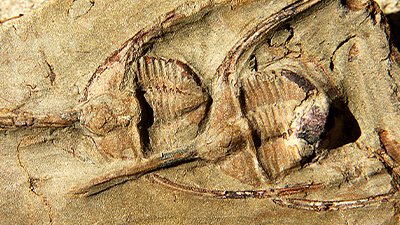
Does This Evolutionary Claim Have Any Legs?
A Preliminary Response
A recent AP article on a new fossil find claims that "snakes evolved on land rather than in the sea.”
As a fossil find,1 it really is nothing new; yet many media outlets are picking up an Associated Press (AP) article2—based on a soon-to-be-released article in the journal Nature—about a snake fossil that supposedly features hind legs. The AP article states that a “new fossil discovery has revealed the most primitive snake known, a crawling creature with two legs, and it provides new evidence that snakes evolved on land rather than in the sea.”
Aside from the questions that would pop up with such a discovery in the context of the raging creation/evolution debate (which we will address in a moment), there is within the evolutionist community a debate over whether the ancestors of snakes were lizards who lived in water or lived on land.3 In other words, evolutionists do not universally agree on how (i.e., where) snakes evolved.

This new snake fossil (allegedly 90 million years old) was found in Argentina, and it will be more formally introduced soon in the increasingly evolution-focused British journal Nature.4 The Nature article attempts to show that this is the first snake fossil that possessed small legs (toward the rear of the skeleton), as well as a bony structure called a sacrum, which supported the pelvis. The evolutionary story is that because this snake had such bones, it is therefore a transitional form between lizards and (legless) snakes. In other words, as snakes evolved away from lizards, their legs eventually disappeared.
With such a new claim, AiG researchers will need to devote some time to evaluate the Nature article when it appears. Meanwhile, here are some preliminary thoughts on the AP story:
- Even if it could be shown that snakes at one time had legs, this actually fits within the creationist model. The loss of features like legs is a type of degeneration, which is the opposite of molecules-to-man evolution (which requires new genetic information for advancement).
- Researchers acknowledged that this snake crawled like the snakes of today. They have not proposed how it used its legs (their guess may be revealed in the Nature article).
- Because some evolutionists may continue to claim that snakes “came out of the sea,” the land vs. sea controversy in the evolutionist community may still not be settled. Some evolutionists might argue for “convergence” (i.e., arguing that the legs on this snake are not due to a common inheritance with lizards—but, then, what are they transitions from?). Evolutionists may never agree on whether this new find is truly transitional.
- We have noted before that supposed “legs” on snakes could be used for playing a role in mating (i.e., the appendages function as claspers, not as legs; also, see our article on whales that supposedly have been found with “legs,” Walking Whales, Nested Hierarchies, and Chimeras: Do They Exist?).
- Those who claim that snakes are just legless descendants of other reptiles really don’t understand their uniqueness. Snakes have a specially designed backbone, which is very different from other reptiles. For a lizard to turn into a snake over time, it would need special backbones. Snakes could not slither without these additions.
- AiG is cautious about comparing this fossil snake to the serpent in Genesis 3:14. First, we really don’t know much about the serpent’s anatomy anyway. Yet we can offer a reasonable guess that it apparently was once able to crawl or walk; after the serpent was cursed, it was pronounced that “on thy belly shalt thou go,” suggesting that it previously moved using appendages.5 Also, this fossil probably resulted during Noah’s Flood, an event that took place about 1,500 years after the serpent was cursed to crawl on its belly.
Footnotes
- The AiG staff scientist most qualified to review this fossil is Dr. David Menton (who holds a PhD in anatomy from Brown University). He is currently on an international speaking tour and thus has limited access to research regarding this newly announced fossil find; in fact, as we write this preliminary web article, the original research has not yet been posted to the website of the journal Nature. We are writing this preliminary response based largely on the contents of an Associated Press article, which featured interviews with scientists involved in the fossil snake’s research.
- For example, the worldwide service of CNN picked up the AP story—see Fossil suggests snakes evolved on land <http://www.cnn.com/2006/TECH/science/04/19/fossil.snake.ap/index.html>.
- This snake was found with fossils of creatures that live on land. Since this is considered an early kind of snake, the find supports those evolutionists who believe that snakes did not come from an aquatic ancestry but rather evolved on land.
- When formally announced, an abstract of the research should be appearing at Nature.com. The full article should also be available for purchase at that site.
- For an article that suggests that snakes may have once had legs, see: C. Brown, “The origin of the snake” (letter), Creation Research Society Quarterly 26:54, 1989. Interestingly, the AP article says that the newly found snake’s name, Najash, comes from the Hebrew word for snake. We won’t make any comment as to the motivation of why evolutionists would choose such a name, but it is tempting.
Recommended Resources

Answers in Genesis is an apologetics ministry, dedicated to helping Christians defend their faith and proclaim the good news of Jesus Christ.
- Customer Service 800.778.3390
- © 2024 Answers in Genesis






